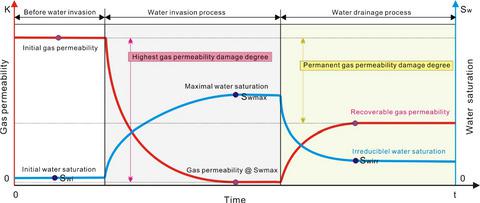当前位置:
X-MOL 学术
›
Energy Sci. Eng.
›
论文详情
Our official English website, www.x-mol.net, welcomes your
feedback! (Note: you will need to create a separate account there.)
Investigation of the controlling rock petrophysical factors on water phase trapping damage in tight gas reservoirs
Energy Science & Engineering ( IF 3.5 ) Pub Date : 2019-11-26 , DOI: 10.1002/ese3.539 Jian Tian 1, 2 , Yili Kang 1 , Na Jia 2 , Pingya Luo 1 , Lijun You 1
Energy Science & Engineering ( IF 3.5 ) Pub Date : 2019-11-26 , DOI: 10.1002/ese3.539 Jian Tian 1, 2 , Yili Kang 1 , Na Jia 2 , Pingya Luo 1 , Lijun You 1
Affiliation

|
This paper presents an investigation into the effect of rock physical parameters on water phase trapping (WPT) damage in tight gas reservoirs. The investigation involved water imbibition and drainage experiments that were performed to simulate the WPT formation process. Gas permeability was measured before and after WPT, and an empirical formula was used to determine water film thickness in order to examine the influence of WPT on effective gas flow channel. Results showed that the average water saturation of 15 tight core samples increased from 19.41% to 44.76% during water imbibition and declined to 38.72% after drainage. Increments in water saturation caused a degree of damage to gas permeability in the 36.03%‐78.10% range with an average value of 59.31%. Comparative analysis showed that the dominant factors affecting WPT were average pore throat radius followed by rock permeability and porosity. Meanwhile, calculations showed that water film thickness in the 21.22‐38.18 nm range correlated to a reduced effective gas flow channel of 20.20‐45.15 nm caused by WPT, which suggests that tight rocks with smaller pore throats may be particularly sensitive to WPT damage. The relative size of the water film filling the pore throat, trapping gas, and reducing the effective gas flow channel together with the size of the pore throat itself were found to be the most common damage mechanisms of WPT and have proven to be fundamentally beneficial in understanding the controlling factors of these damage mechanisms.
中文翻译:

致密气藏中岩石岩石物性因素对水相捕集破坏的控制作用研究
本文研究了岩石物理参数对致密气藏中水相捕集(WPT)损害的影响。该调查涉及吸水和排水实验,以模拟WPT的形成过程。在WPT之前和之后测量气体渗透率,并使用经验公式确定水膜厚度,以检查WPT对有效气体流动通道的影响。结果表明,在吸水过程中,15个致密岩心样品的平均含水饱和度从19.41%增加到44.76%,而在排水后降低到38.72%。水饱和度的增加对气体渗透率的损害程度为36.03%-78.10%,平均值为59.31%。对比分析表明,影响WPT的主要因素是平均孔喉半径,其次是岩石渗透率和孔隙率。同时,计算表明,在21.22-38.18 nm范围内的水膜厚度与WPT引起的有效气流通道减少20.20-45.15 nm相关,这表明孔喉较小的致密岩石可能对WPT损害特别敏感。已发现填充孔喉,捕获气体和减少有效气体流动通道的水膜的相对大小以及孔喉本身的大小是WPT的最常见损坏机制,并已被证明在以下方面具有根本性的益处:了解这些破坏机制的控制因素。计算表明,在21.22-38.18 nm范围内的水膜厚度与WPT引起的有效气流通道减少20.20-45.15 nm相关,这表明孔喉较小的致密岩石可能对WPT损害特别敏感。已发现填充孔喉,捕获气体和减少有效气体流动通道的水膜的相对大小以及孔喉本身的大小是WPT的最常见损坏机制,并已被证明在以下方面具有根本性的益处:了解这些破坏机制的控制因素。计算表明,在21.22-38.18 nm范围内的水膜厚度与WPT引起的有效气流通道减少20.20-45.15 nm有关,这表明孔喉较小的致密岩石可能对WPT损害特别敏感。已发现填充孔喉,捕获气体和减少有效气体流动通道的水膜的相对大小以及孔喉本身的大小是WPT的最常见损坏机制,并已被证明在以下方面具有根本性的益处:了解这些破坏机制的控制因素。
更新日期:2019-11-26
中文翻译:

致密气藏中岩石岩石物性因素对水相捕集破坏的控制作用研究
本文研究了岩石物理参数对致密气藏中水相捕集(WPT)损害的影响。该调查涉及吸水和排水实验,以模拟WPT的形成过程。在WPT之前和之后测量气体渗透率,并使用经验公式确定水膜厚度,以检查WPT对有效气体流动通道的影响。结果表明,在吸水过程中,15个致密岩心样品的平均含水饱和度从19.41%增加到44.76%,而在排水后降低到38.72%。水饱和度的增加对气体渗透率的损害程度为36.03%-78.10%,平均值为59.31%。对比分析表明,影响WPT的主要因素是平均孔喉半径,其次是岩石渗透率和孔隙率。同时,计算表明,在21.22-38.18 nm范围内的水膜厚度与WPT引起的有效气流通道减少20.20-45.15 nm相关,这表明孔喉较小的致密岩石可能对WPT损害特别敏感。已发现填充孔喉,捕获气体和减少有效气体流动通道的水膜的相对大小以及孔喉本身的大小是WPT的最常见损坏机制,并已被证明在以下方面具有根本性的益处:了解这些破坏机制的控制因素。计算表明,在21.22-38.18 nm范围内的水膜厚度与WPT引起的有效气流通道减少20.20-45.15 nm相关,这表明孔喉较小的致密岩石可能对WPT损害特别敏感。已发现填充孔喉,捕获气体和减少有效气体流动通道的水膜的相对大小以及孔喉本身的大小是WPT的最常见损坏机制,并已被证明在以下方面具有根本性的益处:了解这些破坏机制的控制因素。计算表明,在21.22-38.18 nm范围内的水膜厚度与WPT引起的有效气流通道减少20.20-45.15 nm有关,这表明孔喉较小的致密岩石可能对WPT损害特别敏感。已发现填充孔喉,捕获气体和减少有效气体流动通道的水膜的相对大小以及孔喉本身的大小是WPT的最常见损坏机制,并已被证明在以下方面具有根本性的益处:了解这些破坏机制的控制因素。











































 京公网安备 11010802027423号
京公网安备 11010802027423号